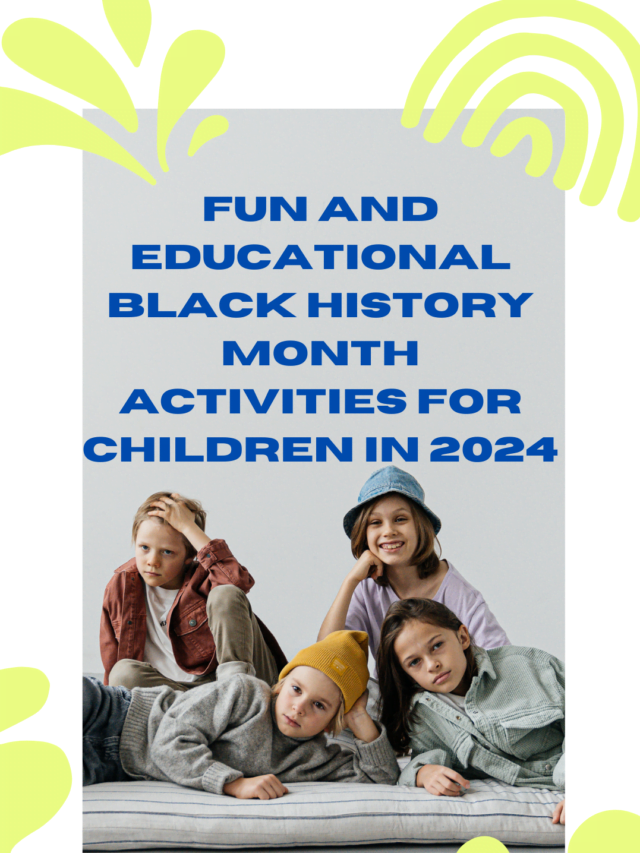February month brings a lot of Black History Month Activities for everyone. It represents more than just the second month on the calendar. It is a period that has been dedicated to celebrating and honoring the countless contributions and dramatic history of African Americans for generations.
As we dive into the realm of Black History Month in 2024, we’ve curated a list of 15 incredibly engaging and educational Black History Month activities specially designed for children.

Table of Contents
Creative Visual Art Projects:
Learning about history needn’t always be verbose. Art is a captivating combination of aesthetics and narration which makes it a perfect medium to teach history.
Designing African Masks:

Masks have held an essential place in many African cultures for centuries. They are more than just facial decor; they signify societal roles, religious beliefs, and are integral to various ceremonies. Let your children channel their inner creativity and learn about the importance of these masks by trying to design their own.
Making a Black History Month Collage:

A picture is worth a thousand words, and sometimes, they convey a lot more than words can. Collect pictures and facts about significant figures and moments in black history, such as Martin Luther King Jr., Rosa Parks, or the Harlem Renaissance, and let your kids create a vibrant collage.
African Inspired Batik Art:

Batik is a traditional African art form using wax to create beautiful patterns on fabric. Guide your children to make their own mini textiles while explaining the cultural significance of Batik art in African communities.
Storytelling and Book Projects:
Books can be powerful tools. They not only entertain but also educate us about the world and its diverse cultures.
Read\ Aloud Sessions:

Devote some storytime to books featuring African American characters or those written by black authors. They can range from historical figures to everyday heroes or characters.
Organize Book Clubs:

Allow children to dive deeper into stories that showcase the struggles and achievements of Black people. Discuss the characters, their struggles, and victories, fostering empathy and understanding in the kids.
Creating Comic Strips:

Comic strips are a fun and engaging way of narrating history. Encourage your kids to pick an event or figure from Black history and illustrate it as a comic strip, promoting creativity and historical understanding.
Historical Field Trips and Virtual Tours:
Experiential learning makes concepts stick for longer periods than traditional learning.
Virtual Tour to Smithsonian’s National Museum of African American History and Culture:

Thanks to technology, you can now visit prestigious museums from the comfort of your home. This specific museum provides an extensive collection of artifacts, narratives, and interactive exhibitions relating to black history and culture.
Local Historical Sites:

There’s always something enchanting about local history. Take your children on a field trip to local landmarks or sites related to Black history and let the surroundings narrate the stories.
Organize a Community Walk:

Organize a local community walk, discussing notable black leaders from your area, their contributions, and influence. This activity can inspire important conversations and a sense of local pride.
Interactive Educational Activities:
Engaging children in interactive educational activities can make learning exciting and more relatable.
Family Tree Project:

It’s time for kids to explore their roots. A family tree project can not only help them understand their heritage but also relate them to larger historical events.
Black History Month Bingo:

Swap the typical bingo calls with mentions of key figures and events in Black history. This will keep learning fun and engaging.
Poetry Workshop:

Immerse students in the rich world of Black poetry. Let them read, discuss, and even try their hand at writing their own poems inspired by the themes and styles of famous Black poets.
Kitchen-based learning
In the kitchen lies a whole other realm of potential learning.
Baking and Cooking Traditional African\American Recipes:

Immerse students in the rich world of Black poetry. Let them read, discuss, and even try their hand at writing their own poems inspired by the themes and styles of famous Black poets.
Food and Traditions:

Discuss how food traditions got intertwined with history, how they evolved over time, and what they stand for today.
Food Tasting and Storytelling:

Introduce kids to different foods associated with African-American culture and let the stories behind these dishes unfold.
Conclusion
Educating children about black history is crucial as it helps to foster understanding and respect, break down prejudice, and build bridges across cultures. However, black history is more than just one month; it’s an integral part of world history, to be remembered, acknowledged, and appreciated all year round.
Black History Month began as a week-long observance in 1926, initiated by historian Carter G. Woodson, and later expanded into a full month in 1976. One of the best ways to make this history meaningful to younger generations is through engaging activities which make learning fun.
Learning about Black history should be more than just reading names or dates from textbooks. Exciting and immersive activities not only spark curiosity, but also forge a deep and personal connection with history, provoke thoughtful conversation, and promote a greater understanding of diverse cultures.







